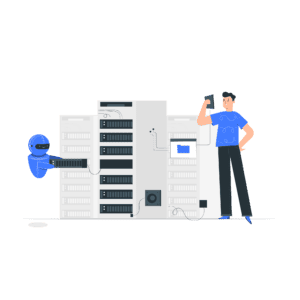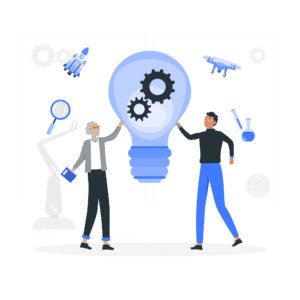SAP ERP has been the leader in business applications. This software contains all types of functions that a business needs to thrive in a digital world. It has long been the backbone of enterprise operations. But change is coming, SAP ECC will officially reach its end-of-life in 2027, and the window to act is closing quickly. Companies that delay this, risk costly challenges, unsupported systems and missed opportunities for digital transformation. 
The solution? SAP S/4HANA, the next-generation ERP platform designed for intelligent decision-making. But getting there requires a critical step, SAP data migration.
SAP data migration isn’t for the faint of heart — the process typically lasts eight months and there is a range of methodologies that ensure your data is transfer effortlessly. This is why many customers have questions about SAP data migration services.
Here are 10 commonly asked SAP data migration questions.
-
What Are the Common Terms to Know?
During the data migration process, you’ll see some terms you may be unfamiliar with. Here are a few examples of their definitions.
- Big Five — customer master, material master, bill of materials (BOM), vendor master, and routings.
- Business objects — data is treated as your business objects during the analysis and transfer process.
- Business object owner — the one that owns the data or the one that’s most affected if the business object doesn’t work. They will make the strategic choices on business object requirements and conducts the final validation of converted data.
- Data conversion and data migration — converting data from the original platform to SAP. These terms are used interchangeably.
- DC — abbreviation for data conversion
- Domain — functional area within the project, such as sales, finance, production, etc.
- Flat file — file format used to import data. It’s a plain text file with a tab separator between fields.
- Intermediate file — a file that’s manipulated between the LS extraction and the flat file generation. Any file type can be made into an intermediate file, but it’s commonly either an Excel or an Access file.
- LSMW — an acronym that stands for Legacy System Migration Workbench. A conversion SAP tool that loads data using flat files.
- Cross-reference table (also called X-Ref table) — when one field is a parent field, this table shows the relation between the fields.
- WBS — acronym that stands for Work Breakdown Structure.
- IDOCs –an SAP object that carries data of a business transaction from one system to another in the form of electronic message. IDoc is an acronym for Intermediate Document.
As you migrate your data, you’ll start to understand these terms and their purpose better.
-
What Are the Main Steps of the Conversion Methodology?
The main steps of data conversion are:
- Determine your data conversion strategy
- Identify WBS and workload estimates
- Develop a Project plan
You also shouldn’t forget Business Objects data conversion. Some of the steps in this process include:
- Map source to target data structures and determine conversion rules
- Purge and cleanse data to be migrated
- Implement data quality rules
- Develop extraction, transformation and load programs
It’s important you spend a couple of weeks on your SAP data migration methodology to educate your team on the methodology you will be using. Doing so ensures that your plan is organized and that you and your team are in sync. By reviewing your data migration methodology, you may detect potential issues and risks that can be resolved before or during the execution of your SAP data migration.
-
What Is Data Purging and Cleansing?
Data purging is the SAP data migration approach of deleting old and obsolete data before the conversion process, such as data from old customers. Data archiving could also be included in this process.
Data cleansing corrects data inconsistencies and ensures the data is correct before the migration process. This step is important because it will save you time during the migration and can even help lower the SAP data migration cost.
You won’t worry about old or incorrect data adding time to your data migration. Anyone can also do this process — you don’t need specialty help or an SAP expert for this step.
- What Are the Three Types of Data in an SAP System?
There are three types of data in an SAP system:
- Transactional data
- Master data
- Historical data
Transactional data is anything current and outstanding that is necessary for business process completion. Common examples include open purchase orders, accounting documents, backorders, and open sales orders.
Master data is also outstanding data, but it’s more static than transactional data. Common examples include data on customers, vendors, assets, charts of accounts, material masters, bills of materials, and info records.
Historical data is not current but is still used for reference. Common examples include closed sales orders, closed purchase orders, and summary general ledger information.
- What are the 3 Master Data to focus on?

- SAP Customer Master – includes information of all customer relations and creates the baseline of the sales and distribution process within an organization. It contains specifics about customers which require to be maintained to ensure a seamless workflow between all transactions and other processes such as Procure-to-Pay, Order-to-Cash, Record-to-Report, Hire-to-Retire, and Plan to Produce .
- SAP Vendor Master – Holds information of all the materials and supplies a company procures from all their different vendors. Every vendor has an assigned value within the SAP system and Vendor Master holds information such as name, address, currency used, tax details, etc.
- SAP Material Master – Comprises information of all the materials and supplies a company procures, produces, stores, and sells. It allows companies to have insight on matters such as lead times, MRP levels, resource planning parameters, and lists of current suppliers.
Material Master drives various business processes and serves as a company’s hub for collecting material-specific data stored within individual material master records.
Focus on these 3 and build the process for extraction, cleansing, transformation and loading of these 3 masters. Once you’ve done these, with the experience and knowledge that you’ve gained – migration of all other objects becomes a breeze.
- What About Greenfield and Brownfield Migration?
Greenfield migration projects are new software applications where you’re using an entirely new platform with a recent architecture and even the latest technologies.
Each of these strategies require a tailored SAP data migration approach. For instance, in a Greenfield strategy, everything is started from scratch. That includes the applications and operating systems. This strategy tends to be heavier and has a higher workload as nearly all data must be transferred to the brand-new infrastructure.
Brownfield migration projects involve an upgrade to the latest version of a platform using the existing technology. The effort involved in a Brownfield migration is lighter but tends to come with requirements such as upgrading Customer/Vendor Information (CVI).
- How Do You Work with the SAP Data Migration Cockpit?
The SAP S/4HANA Migration Cockpit is a browser based automated migration tool embedded and delivered with implementation of the S/4HANA system.
This tool helps automate much of the SAP data migration effort and comes preconfigured with content and mapping for migration objects regarding all major operating areas, such as: product, customer, cost center, profit center and GL. Each of these migration objects has a corresponding, predefined template that allows for source data to be automatically mapped to target structures.
The migration cockpit allows for the download of a predefined excel sheet which can be filled in using legacy data and then uploaded to the S/4HANA system.
In the Grainger case study, for example, Auritas leveraged the Migration Cockpit with our own data extraction and cleansing pipelines. This allowed Grainger to accelerate their migration timeline while maintaining data integrity, reduce manual data entry and ensure harmonized data entered the new environment. Which helped improve business processes post-migration.
- How Does SAP Landscape Transformation Software Make the Process Simpler?
SAP Landscape Transformation Software is a product from SAP that simplifies your technological structure. It allows for companies to have complete data consistency and integrity for transformation projects such as data migrations and data conversions.
This software aids companies in realigning their SAP system landscape after large restructurings to their business such as: divestitures, acquisitions, mergers, or major updates to their current business processes.
The SAP Landscape Transformation Software supports, accelerates, and optimizes IT and Business transformations using an SAP provided collection of core analytical programs which guarantee optimized processes, complete historical data, increased agility, and security in place to avoid any potential loss of data.
- What Is System Landscape Optimization?
System Landscape Optimization (SLO) helps you align business goals with SAP systems using automation and smart planning. It’s often used to streamline SAP data migration by enhancing existing transformation tools, such as divestitures and splits, mergers and acquisitions, and more.
- What Is Business Partner in S/4?
In S/4 – Business partner allows enterprises to consolidate the information for both customer and vendor data into a business partner profile, resulting in an efficient transfer of master records. As a trusted SAP-certified partner, Auritas plays a key role in helping organizations adapt to the new S/4HANA Business Partner data model. In the ECC system, customers and vendors were managed separately—but in S/4HANA, these are now unified into a single Business Partner profile.
This structural shift helps consolidate master data, reduce duplication and streamline data governance. The transition must be managed carefully though, especially during SAP data migration.
With a proven track record, Auritas helps companies accelerate this transition, making data migration smarter and faster. Within a four-month period, Auritas configured Azure Storage and migrated 9,229 ISO volumes and 23TB of legacy data to the Azure Cloud, helping a company save significant costs.
Migrating can be a major initiative but with the right preparation it doesn’t have to be overwhelming. Understanding core concepts and leveraging the right tools and methodologies can turn an obstacle into an opportunity. From mastering terminology and methodology to choosing between Greenfield or Brownfield strategies, every decision you make impacts the success of your migration. Whether you’re just starting out or deep into your planning, Auritas is here to help make your SAP data migration a breeze.
Schedule a call with us today to learn more about the next step to take!
